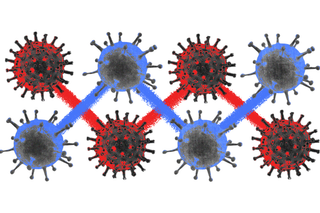
All You Need to Know About ‘Flurona’
Being infected with Covid19 and the flu at the same time could be “catastrophic to your immune system,” an expert said.

The word “flurona” feels like a practical joke a week into the new year. But it’s what’s being colloquially used to signify a co-infection that was detected last week. A verified influenza-Covid19 infection emerged in Israel last week, when an unvaccinated pregnant woman tested positive for Covid19 while feeling mild symptoms. The health officials opine this is not the only case of flurona, but just the first confirmed one.
To clarify: flurona is not a variant (one or more new mutations to the original virus) — but a dual infection.
We know co-infections are a possibility; people can contract two different viruses, just like they contract Covid19 and the flu together. Call it a double whammy, if you will. With the spread of Omicron variant globally, the challenge is to know whether symptoms like fatigue or sore throat are a result of a) only the flu, b) Covid19, or c) both.
How did flurona come into focus now? See, right from the beginning, experts expressed concern about a potential “twindemic,” urging countries to ramp up flu shot coverage. In the initial months, lockdowns and mask-wearing helped curb influenza during winters last year. But now as societies relax curbs, cases of influenza are expected to shoot up. “My main fear is we will see cases of maybe influenza, maybe COVID, maybe some of the other respiratory viruses, and because rapid testing is not available on a widespread basis, we will be in front of the people and we won’t know what they have,” Dr. Julita Mir told USA Today.
The question now is how the two viruses impact someone who contracts them at the same time. Both Covid19 and influenza are respiratory diseases; they spread through droplets and aerosols when an infected person breathes, speaks, coughs, or sneezes. As airborne diseases they infect the same human tissues (respiratory tract, and nasal, bronchial, and lung cells). The “overlap of the Covid19 pandemic and seasonal influenza might place a large population under high risk for concurrent infection with these two viruses,” a Nature report noted.
People can get infected by both when people touch contaminated surfaces and then touch theireyes, mouth, or nose without cleaning theirhands. The World Health Organization notes the symptoms of both look very similar — dry cough, sore throat, fatigue, fever, headache.
Similarprotective measures can be used for both. Social distancing; avoiding crowded places; coughing or sneezing into a bent elbow or tissues; cleaning your hands frequently; getting vaccinated. You know the drill.
Related on The Swaddle:
Omicron Variant Did Not ‘Originate’ in South Africa, It Was ‘Detected’ There. The Difference Matters
But they are still caused by two different viruses — Covid19 by a coronavirus first identified in 2019, and influenza is caused due to influenza viruses. In flu, a person experiences symptoms 1 to 4 days after infection; while someone with Covid19 will experience an onset of symptoms about 5 days after, but symptoms can appear 2 to 14 days after infection. Naturally, the vaccine protection doesn’t swing both ways; Covid19 vaccines do not protect against influenza, and the flu vaccine does not protect against Covid19.
Still, there’s a lot we don’t know about flurona, or how the flu virus and SARS-CoV-2 work in tandem within the body. In January 2020, an early study in China found zero cases of coinfection among 99 Covid19 patients. However, a follow-up study in February later concluded that about one in eight had both diseases at the same time.
The co-infection may not be particularly bad. In the present case, the Israeli woman reported feeling mild symptoms and was discharged from the hospital a few days later. In some cases, for instance, many Covid19 patients have bacteria, fungi, or other viruses in their systems but they don’t work to increase their vulnerability. “Our immune systems can produce different antibodies simultaneously, so they can typically multitask against different pathogens,” Roxanne Khamsi explained in The Atlantic.
The severity and frequency of this co-infection, or for any other combination, are both uncertain. There are two concerns at play. For one, getting infected with Covid19 and the flu at the same time could be “catastrophic to your immune system,” Dr. Adrian Burrowes, a family medicine physician and assistant professor of family medicine at the University of Central Florida, told CNN in September. He added that we could see a higher mortality rate because of this. “The presence of both viruses could result in a full range of severe symptoms including pneumonia, respiratory complications, and myocarditis, which could lead to death if left untreated,” CNBC TV explained.
Then, the worry is also that Covid19 and influenza would combine to overwhelm health systems. “After you have a year with a very, very low or not at all influenza activity, the next year because people were less exposed, it makes them more vulnerable,” Nadav Davidovitch, Director of the School of Public Health at Ben-Gurion University in Israel, told CNN. To be fair, we don’t know if hospitalization increases for people with a dual infection as compared to someone infected with just one. But “we are seeing more and more morbidity of influenza among the maternity population, along with cases of corona that mainly occur in women not vaccinated against corona and influenza,” Arnon Wiznitzer, director of the Beilinson Women’s Department, Israel, said in the statement.
Moreover, “looking for coinfections creates more work for doctors, and interpreting the results when they find multiple pathogens lurking inside someone’s organs makes for an even bigger clinical headache,” Khamsi argued. Within India, vaccinations against influenza are uncommon — mostly owing to a lack of awareness, limited access, and steep prices. They are also not included within the government’s universal immunization program that factors in tuberculosis, polio, and Hepatitis B. Reportedly, the demand for flu shots has increased during Covid19.
Even the Nature report noted influenza “has a unique ability to aggravate SARS-CoV-2 infection,” and thus, prevention “is of great significance during the Covid19 pandemic.”
It feels like a cocktail of crisis. The timing of Omicron, the discovery of another variant discovered in Southern France this week, a slower pace of rolling out booster doses within India. This makes variants and co-infections likely to spread at a faster rate and pull the rugs under an already depleted health system.
Saumya Kalia is an Associate Editor at The Swaddle. Her journalism and writing explore issues of social justice, digital sub-cultures, media ecosystem, literature, and memory as they cut across socio-cultural periods. You can reach her at @Saumya_Kalia.
Related


With Omicron, Can Home Testing Prevent Overburdening Healthcare Systems?
